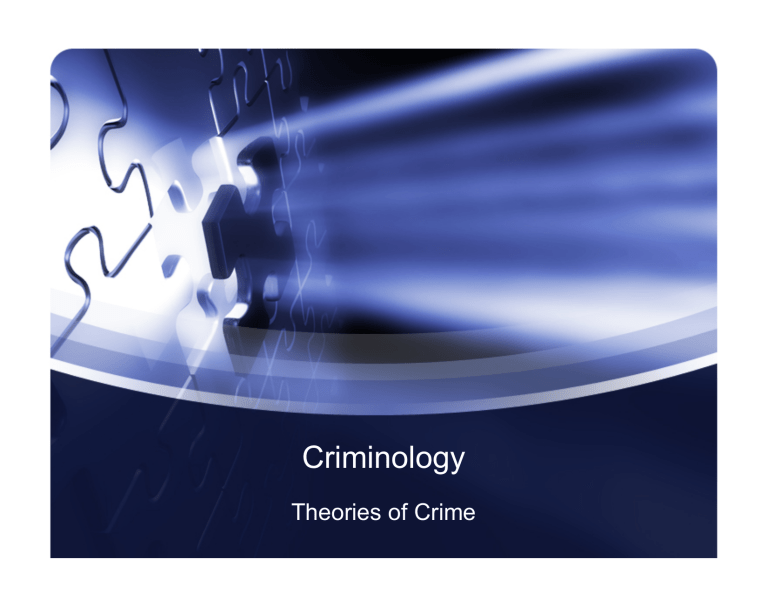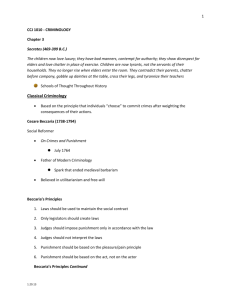Criminology

Criminology
Theories of Crime
Criminology
• Not just crimes but boardrooms where banking decisions are made, to ships moving people, and goods around the word streets children cannot play safely- to places where ethnic interests collide
• They look at everything interested in human behavior, drugs and drug addiction, and criminal sanctions
• Trying to discover why people do what they do- why do criminals break the law
Criminology Definition
• The body of knowledge regarding crime as a social phenomenon. It includes within its scope the process of making laws, of breaking laws, and of reacting toward the breaking of laws… The objective of criminology is the development of a body of general and verified principles and of other types of knowledge regarding this process of law, crime, and treatment or prevention
Crime
• Any rational human conduct that violates a criminal law and is subject to punishment.
• Deviance defined (see earlier notes)
• We all break laws- small steps at first
• Criminologists look at all economic classes and determine who is more or less likely to commit crime
• 3 reasons to measure crime
– In order to test theories
– Enhance knowledge or certain characteristics
– Information to facilitate daily operations and to anticipate future needs.
Classical School of Criminology
• Greek historian- Thucydides- believed wrong doers needed penitence (remorse) by the criminal in exchange for cultivation or forgiveness by god- Punishment at this time was brutal
• The philosophical approach culminated in the middle of the 18th century based on the assumption that individuals choose to commit crimes after weighing the consequences of their actions. They all have free will.
– Positivist School behavior is determined by forces beyond individuals control- view violent criminal behavior
Classical School cont.
• The Classical School grew out of a reaction against barbaric system of law, punishment, and justice that existed pre-
French revolutionary war 1789.
• Punishments at this time included branding, burning, flogging, mutilation, drowning, banishment, and beheading.
• In England a person could receive the death penalty for some zoo crimes
Cesare Beccaria
• “Father of Criminology” believed that crime could be traced back to bad laws not people. He proposed
– Laws should be used to maintain the social contact
– Only legislatures should create laws
– Judges should impose punishment only in accordance with the laws
– Judges should not interpret laws
– Punishment should be based on the act not on the actor
– Punishment should be determined by the crime
– Punishment should be prompt and effective
– Al people should be treated equally
– Capital Punishment should be abolished
– The use of torture to gain confessions should be abolished
– Its better to prevent crimes than to punish them
Jeremy Bentham
• Utilitarianism- assumes that all human actions are calculated in accordance with their likelihood of bringing happiness
(pleasure) or unhappiness (pain). People weigh the probabilities of present and future pleasures against those of present and future pain.
Biological Determinism
• Cesare Lombroso (1835-1909)
– Was an Army physician and later a psychologist
– Wrote L’uomo delinquente (The Criminal
Mind) in 1875 which permanently transformed criminology from an abstract philosophy of crime control through legislation to modern science of investigation into causes
– His theory: the Born Criminal
The Born Criminal
• He believed that criminals are a lower form of life, nearer to their ape like ancestors
• Atavistic Stigmata- physical features of creature at an earlier stage of development- before they fully become human
• Large teeth, huge jaws, long arms, extended foreheads-females: a “monster” revengeful, jealous, vengeance
• 2 categories:
– Insane Criminals- not a criminal from birth; they become criminal as a result of some change in their brains which interferes with their ability to distinguish between right and wrong
– Criminoloids- make up an ambiguous group that includes habitual criminals, criminals by passion, and other diverse types
Enrico Ferri (1856-1929)
• Agreed with Lombroso on the biological bases of criminal behavior his interest in socialism led him to recognize the importance of social, economic, and political determinants
• Believed criminals could not be held morally responsible because they did not choose to commit crimes but, rather were driven to commit them by conditions in their lives.
• Although he advocated conventional punishments and even the death penalty for individuals he assumed would never fit into society- more interested in controlling crime through preventative measures
Raffaele Garofalo (1852-1934)
• Rejected the doctrine of free will and supported the only way to understand crime was to study it nu scientific methods
• Traced the roots of criminal behavior not to physical features but to their psychological equivalents- called “moral anomalies”
• Natural Crimes according to this theory are found in all human societies regardless of the views or lawmakers, and no civilized society can afford to disregard them.
• Natural Crimes are those that offend the basic moral sentiments of probity (respect for the property of others)
• More interested in protecting society than in the individual rights of offenders.
Somatotype
• Related body build to behavior, became popular during the first half of the twentieth century.
• 3 principle types of physiques (according to Ernst Kretschmer)
– Asthenic- lean, slightly built, narrow shoulders
– Athletic- medium to tall, strong, muscular, coarse bones
– Pyknic- medium height , rounded figure, massive neck, broad face
A Different Approach
• Pyknics= manic depressive, Asthenics and Athletic= schizophrenia
• Robert Dugdale (1841-1883)
– While everyone else was so enthralled by the biological theory and the physical nature of it all Dugdal believed there to be another reason for crime.
– Inherited Criminality- criminal genes are passed down via genetics
The “Jukes”
• 6 wound up in prison in upstate NY and sparked the interest of Dr. Dugdale.
• Following Ada Jukes family lineage whom he referred to as the “mother of criminals”
– 280 paupers, 60 thieves, 7 murderers, 40 other criminals, 40 persons with venereal disease, and 50 prostitutes.
Psychological Theory
• What is the psychopathology on crime?
• What are three basic principals that psychologists still consider?
Ivan Pavlov
Sigmund Freud (1856-1939)
• Suggested that criminality may result from an overactive conscience.
• Id, Ego, Superego
Chicago School
• Sociological Theory
Emile Durkheim
Robert Merton
Social Process Theory
• Edwin Sutherland
Walter Reckless
• Two types of containment:
• Travis Hirschi
• What are four components that bond
“You’re a loser and always will be”
• Labeling theory:
• “Moral Enterprise”
Conflict Theory
Feminist Approach
DNA… what’s in your genes??
• Psychobiological









